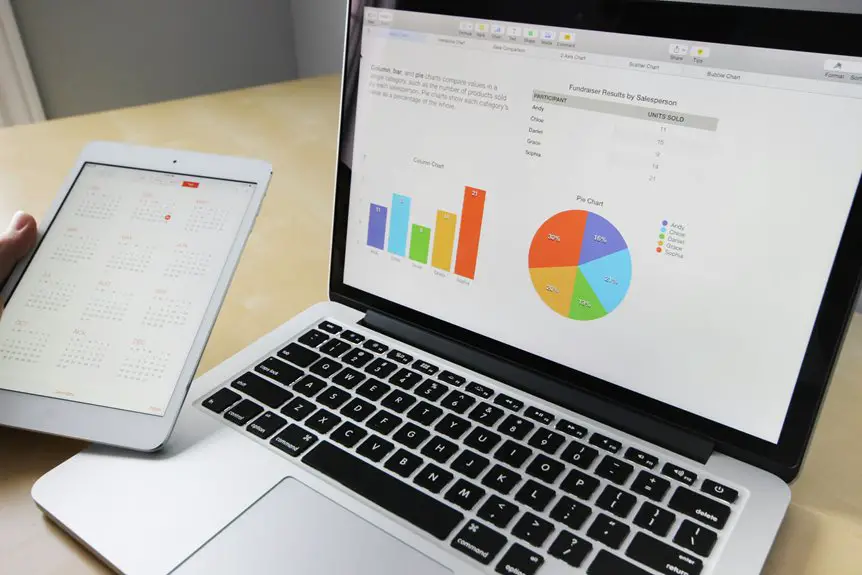When it comes to financial analysis, choosing the right monitor can significantly impact your efficiency and accuracy. You'll want to consider factors like screen size, resolution, and panel type to ensure you can manage complex data effectively. It's not just about having a large screen; clarity and color accuracy play crucial roles, too. Let's explore how these elements can enhance your workflow and what specific features you should prioritize.
Key Takeaways
- Select a monitor size of at least 27 inches for efficient multitasking with multiple spreadsheets and charts.
- Opt for a minimum resolution of 1920×1080 for clear text and images, or 4K for detailed financial analysis.
- Choose a higher refresh rate to ensure smooth visuals and reduce lag when tracking real-time data changes.
- Prefer IPS panel technology for superior color accuracy and wide viewing angles, essential for detailed financial work.
- Ensure connectivity options like HDMI, DisplayPort, or USB-C to maintain compatibility with your existing setup.
Screen Size: Finding the Right Fit
When choosing a monitor for financial analysis, the screen size can make a significant difference in your workflow.
You'll want to ensure your screen is large enough to display multiple spreadsheets or applications simultaneously, which can enhance your efficiency. A 27-inch monitor often strikes the right balance, providing ample space without overwhelming your desk.
If you're working with detailed charts or graphs, consider a larger monitor, like a 32-inch model, to help you analyze data more easily.
Keep in mind that a bigger screen can reduce eye strain and improve productivity.
Ultimately, finding the right fit helps you stay organized and focused, ensuring you can make informed financial decisions without unnecessary distractions.
Resolution: Clarity for Complex Data
Screen size plays an important role, but resolution is equally vital for financial analysis. Higher resolution means more pixels, resulting in sharper images and clearer text.
When you're analyzing complex financial data, you need to see every detail without straining your eyes. A monitor with at least 1920×1080 (Full HD) resolution is a good starting point, but consider 4K (3840×2160) for even better clarity, especially if you regularly work with multiple spreadsheets or detailed graphs.
This level of detail helps you identify trends, spot anomalies, and make informed decisions quickly. Ultimately, investing in a monitor with the right resolution can significantly enhance your productivity and accuracy in financial analysis, ensuring that you never miss crucial insights.
Refresh Rate: Importance in Financial Analysis
While you mightn't think about refresh rate when choosing a monitor for financial analysis, it can significantly impact your workflow. A higher refresh rate ensures smoother visuals, which can enhance your ability to track market movements and data changes.
Here's why it matters:
- Real-time Data: You can monitor stock prices and trends without lag, keeping you responsive to market shifts.
- Reduced Eye Strain: Higher refresh rates lead to less flicker, making it easier to analyze data over long periods.
- Improved Multitasking: With a smooth display, switching between applications feels seamless, enhancing productivity.
- Enhanced Focus: A clear, stable image allows you to concentrate better on intricate financial details.
Choosing the right refresh rate can truly elevate your financial analysis experience.
Panel Type: Choosing the Best Display Technology
After considering refresh rates, the next key factor in optimizing your financial analysis setup is the panel type.
You'll typically encounter three main types: IPS, TN, and VA. IPS panels offer superior color accuracy and wide viewing angles, making them ideal for detailed financial charts. TN panels are faster and more affordable, but they sacrifice color quality and viewing angles.
If you need a balance between contrast and color, VA panels might be your best bet, providing deeper blacks and good color reproduction.
Think about how you'll use your monitor: if high fidelity and detail matter most, go for IPS. However, if speed or budget's a concern, consider TN or VA.
Choose wisely to enhance your analysis experience!
Connectivity Options: Ensuring Compatibility With Your Setup
To maximize your financial analysis efficiency, it's essential to consider the connectivity options available on your monitor.
You want to ensure your setup is seamless and compatible with your devices. Here are four key connectivity options to look for:
- HDMI Ports: Ideal for connecting laptops and desktops, providing high-quality video and audio.
- DisplayPort: Great for multiple monitor setups, supporting higher resolutions and refresh rates.
- USB-C: Perfect for modern laptops, offering video, data transfer, and charging through a single cable.
- VGA/DVI: Useful for older devices, though less common now, it's good to have for legacy support.
Frequently Asked Questions
What Budget Should I Allocate for a Monitor for Financial Analysis?
You should allocate between $200 to $800 for a monitor, depending on your needs. Higher budgets provide better resolution and features, while lower budgets can still meet basic financial analysis requirements effectively.
How Does Lighting Affect Monitor Visibility in Financial Environments?
Lighting significantly impacts monitor visibility. You'll want to minimize glare from windows and overhead lights. Adjusting your monitor's brightness and contrast can help you clearly see data, enhancing your overall analysis experience.
Is Curved Versus Flat Screens Better for Financial Analysis?
When deciding between curved and flat screens, consider your workspace and viewing habits. Curved screens can enhance immersion and reduce glare, while flat screens offer easier multi-monitor setups. Choose what feels most comfortable for your analysis.
Can a Laptop Monitor Be Used for Financial Analysis Effectively?
Yes, a laptop monitor can effectively handle financial analysis, especially if it offers good resolution and size. Just ensure you have enough screen real estate for multitasking and clear visibility of your data.
What Brands Are Most Reliable for Financial Analysis Monitors?
When considering reliable brands for financial analysis monitors, you'll find Dell, ASUS, and LG often stand out. They offer excellent color accuracy, resolution, and durability, ensuring you get the most out of your financial data.
